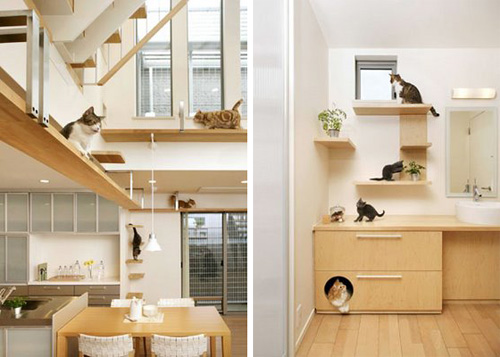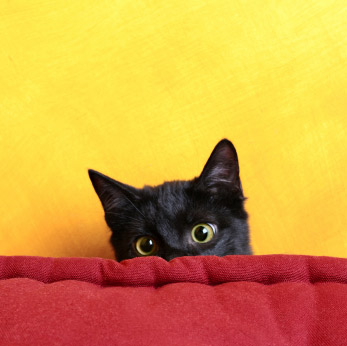 |
 |
 Housekeeping is a casual
affair for some and a major event for others. Adopting a pet can help to
transform your house into a home, but your new four-legged friend could also
turn your home into a mess. With a little thinking ahead, you can have a happy
pet and a clean home! Here are some tips for achieving just that: Housekeeping is a casual
affair for some and a major event for others. Adopting a pet can help to
transform your house into a home, but your new four-legged friend could also
turn your home into a mess. With a little thinking ahead, you can have a happy
pet and a clean home! Here are some tips for achieving just that:
Clean Pets = Clean House
-
Keep your pets well-groomed. Frequent brushing outdoors will keep indoor
shedding to a minimum. If need be, trim excess hair so that dirt and waste
won't cling.
-
Keep your pet's nails trimmed, filing down any edges that could shred
upholstery.
-
Wipe off your pet's jowls and long, floppy ears after each meal.
-
Placing a large, absorbent place mat under food and water bowls will make
for easier clean-up.
-
Utilize dog crates and gates to confine your new dog when home alone until you
are comfortable enough to grant him/her unsupervised freedom.
Furniture
-
Place machine-washable slip covers over lightly colored furniture that is more
apt to show stains.
-
Vinyl and leather furniture is easy to
clean. Just make sure your pet's nails are trimmed, as they can damage those
materials.
-
Place a comfy bed for your pet in a designated room or corner. Cover the bed
with a machine-washable throw and train your pet that this is the only piece of
furniture they are allowed to frequent.
Floors
-
You can easily wipe away pet waste on sheet linoleum, tile and Pergo® floor
surfaces. Use polyurethane to seal hardwood floors in order to prevent
lingering urine odor.
-
Try to use washable area rugs instead of wall-to-wall carpeting. If urine soaks
into carpet backing, it can be impossible to clean. A carpet care product that
targets pet stains can prove indispensable if you have carpeting.
-
Roll up vegetable-dyed oriental rugs until your new pet is fully house-trained.
If rugs have fringe, don't roll them back out until your pet is done teething,
which can take 8 months or more.
-
Place a washable area rug by the door and keep a towel handy to wipe down your
pet's paws and/or body on rainy or muddy days.
Windows
-
Fabric shades, café curtains, and valances are great window treatments for
pet-friendly homes.
-
Steer clear of pooling drapery, vertical blinds, tassels, and long cords that
can be strangulation hazards, or might bring things crashing down, should your
pet try to pull or climb them.
-
Mini-blinds can get bent beyond repair when they block a curious cat or dog's
view. Think twice about using these as window treatments.
Walls
-
Washable vinyl-backed wallpaper is easier to clean than paper-backed wallpaper.
-
Use washable semi-gloss paint in areas where your new dog will frequent. This
is important for owners of loose-jowled dogs, who are more likely to shake
spittle onto the walls.
-
Paint or hang a washable wall covering on the lower half of walls that have
antique wallpaper or fabric wall treatments.
|
|
 |
 |
 When it comes to dogs and
cats, familiarity is all about scent. Because of this, introducing your newborn
to your pet can start well before you bring the baby home. Before arriving home
with your baby, have your spouse or partner bring home a blanket, undershirt,
or bootie your baby has worn in the hospital, so that your dog can give it a
good sniff. This will give your dog a head's up that there's soon to be another
member of the pack. When it comes to dogs and
cats, familiarity is all about scent. Because of this, introducing your newborn
to your pet can start well before you bring the baby home. Before arriving home
with your baby, have your spouse or partner bring home a blanket, undershirt,
or bootie your baby has worn in the hospital, so that your dog can give it a
good sniff. This will give your dog a head's up that there's soon to be another
member of the pack.
When you finally bring your baby home, have your spouse or partner carry the
infant inside and into another room so that you (the mother) are available to
give the dog undivided attention when you walk in the door. Since you've likely
been away for a few days, your dog will be seeking affection from you. After 5
to 10 minutes of interactive bonding time with your dog, you're ready to
introduce him to your newborn. Offer a toe - never the head - for the dog to
inspect and sniff. If your dog isn't interested, don't force him to inspect
your baby. There will be plenty of chances to try again later.
A few notes regarding safety:
-
Get routine exams for your pet and keep all vaccinations up to date.
-
Give your pet regular nail trims so they can't scratch the baby.
-
Never allow your pet to get in the crib or the bed with your baby, as they
could cause injury or suffocation.
-
You can use double stick tape around the edges of baby furniture or the
changing table to keep pets from jumping up.
-
Use safety gates to keep animals away from the room where your baby sleeps.
-
In the event your newborn gets scratched, wash the area with soap and warm
water, and apply an antibiotic ointment.
-
Notify your pediatrician if you think additional treatment is needed.
|
|
 |
 |
 Felines have a strong
tendency to give off an air of aloofness, but truly shy cats can be all but
invisible-- making themselves very scarce by running, and even hiding from
their owners. At some time during the day, even the most sociable cats want to
be alone and will find a place to seclude themselves for a while. The truly shy
ones, on the other hand, may spend most of their time out of sight. A cat that
spends most of her time under the bed isn't enjoying life, and may not be
getting enough food, water, attention, or exercise. Felines have a strong
tendency to give off an air of aloofness, but truly shy cats can be all but
invisible-- making themselves very scarce by running, and even hiding from
their owners. At some time during the day, even the most sociable cats want to
be alone and will find a place to seclude themselves for a while. The truly shy
ones, on the other hand, may spend most of their time out of sight. A cat that
spends most of her time under the bed isn't enjoying life, and may not be
getting enough food, water, attention, or exercise.
Some breeds are more reserved than others, and some cats, usually those who
have not been around many humans, tend to be people-shy. In some cases, the cat
may be frightened of certain types of people - children or men, for example.
Skittish or shy cats may just need a little love and attention. Give a shy cat
attention but on her terms. Visit with your cat while she's in her favorite
hiding place. Talk to her softly and stroke her lightly on the head. You can
even feed her there if she doesn't come out to eat. Give her the space she
needs, but reassure her with your tone and actions that you mean no harm.
Socializing a shy cat can take weeks, or even months, so be patient.
Cats are naturally nocturnal, but if your cat rarely comes out during the day,
don't assume she's not prowling around the house at night. Just because you
find her in the morning in the same hiding place that you left her in the night
before doesn't mean she spent the whole night there. To help a shy cat feel
more secure, try waiting until nightfall. Turn off all the lights and pull the
shades. Then, wait and see if she is more willing to venture out in your
presence.
Petting, soft talk, and treats can help coax a "scaredy-cat" into
relaxing more around humans. If there's something that your cat particularly
loves, be it a specific food, a rub behind the ear, or a good brushing; reserve
it for occasions of social interaction.
Don't force the issue of socializing your cat. If you try to force unwanted
attention, you may actually make her more reclusive - or risk being scratched
or bitten. Let your shy kitty build confidence in her own time. If a normally
sociable cat starts acting antisocial or begins to hide a lot, notify your vet
in case her shyness is actually a symptom of illness.
|
|
 |
 |
 Where to Bathe Where to Bathe
Some dogs get pretty scared in the bathtub. They jump around, slip and fall,
shiver and shake, and are often quite unhappy. In the process, you can get even
wetter than the dog does, struggling just to keep him in the tub. Instead of a
bath, try giving him a shower-- especially if you have a hand-held shower head.
Your dog should feel much more relaxed standing on firm ground, rather than up to
his chest in a tub of water. You will probably stay much drier and decrease the
risk of hurting your back. Your dog will also get a cleaner rinse.
If you do bathe your dog in the tub, you will need a rubber bath mat or
non-slip stick-ons for the bottom. This will prevent him from slipping and will
make him feel much more secure.
How to Bathe
First, lay a blanket out on the floor in the room where your dog will be
going after his bath; two towels by the shower or tub; his shampoo, conditioner
and a washcloth; a brush and comb; and a trash bag.
If your dog's coat is matted, bathing him first will make that situation even
worse. If you're unable to de-mat your dog's coat yourself, it's probably a job
better suited for a groomer.
In the tub or in the shower, wash your dog's face with a washcloth instead of
pouring lots of water over his face, because his ears shouldn't get too wet
inside -- not to mention the fact that he probably won't enjoy getting doused
over the head.
Use a good dog shampoo if you can, or you can use baby shampoo or a good herbal
shampoo. Either of these should be mild enough to use occasionally for a dog.
If your dog has long hair, you might want to use a conditioner. If your pet
supplier or veterinarian doesn't have a conditioner made just for dogs, you can
find good herbal conditioners that are kind to their skin. Some herbal shampoos
and conditioners meant for humans will even prevent lice and fleas on dogs.
After getting him lathered up and clean, you need to rinse very thoroughly.
Shampoo residue will make his skin itch. Even with a no-tears shampoo, try to
keep it out of his eyes.
How to Dry
When you least expect it, your soaking wet dog is going to give a good thorough
shake from head to tail, which can drench you and the whole bathroom. Dry him
while he's still in the tub to prevent the water from venturing too far outside
of it. You can prevent him from shaking by keeping a towel over his head. You
can use one end of the first towel over his head and dry him with the other
end, using and second towel to pick him up.
Lay your dog on the blanket you laid out and dry him off as much as possible.
His first instinct may be to run and find a good place to shake and roll
around, but try to keep him confined to the blanket until he is completely dry,
even if that means staying with him or setting up a barrier, such as a doggy
gate.
When to Bathe
Bathing your dog too often is not good for his skin, so keep it down to when
company is coming, when he gets into something greasy, when he gets too smelly,
or special situations (say, for instance, he gets sprayed by a skunk).
|
|
 |
|
|
|
 |
|
In This Issue:
|
|
 |
|
Contact Us
|

Name
Phone
Website
|

|
|
Teaching Your Cat Tricks
|
Who says you can't teach a
cat tricks? Believe it or not, a cat can learn almost any trick that a dog can
learn. It just takes a little time, patience, and conditioning. Today, we'll
focus on the most basic commands - sitting and standing.
What You'll Need
- Your cat before mealtime
- A quiet area where the cat is comfortable
- A table for the cat
- A specific command (in this case, the words
"sit" or "stand"), preceded by your cat's name
- Your positive signal (a clicker, or an upbeat word such as
"yes")
- The reward (his favorite food or special treats)
Teaching Your Cat to Sit
1. Gently put the cat on the table at the edge nearest to you, and
pet him so he is comfortable.
2. Show your cat the reward, then give the command "Fluffy,
sit" and move the reward back and over his head.
3. As he tips his head back to follow the food, he will sit to
keep his balance. When he sits, hit the clicker (or use your positive signal)
and say "sit, good sit". Immediately give him his treat.
4. Eventually your cat should respond to the command
"sit" without you having to dangle food over his head.
5. Once your cat has learned this behavior, you no longer need to
place the cat on the table to sit.
In the beginning, if your cat does not sit on his own, you may gently press
down on his hindquarters. Then hit the clicker (or use your positive signal)
and say "sit, good sit." Be gentle and patient. If he resists, try
again another time. It's always better to have him sit on his own.
Teaching Your Cat to Stand
Standing, like the dog trick "beg", is one of the simplest tricks
you can teach your cat, as they often assume this position naturally. Your goal
is to have your cat sit up on his haunches when you give the command
"up" while you hold the reward above him.
Training Steps
1. Put your cat on the table at the edge nearest to you, and pet
him so he is comfortable.
2. Show him the reward, then give the command "Fluffy,
up" while you hold the food directly above him (but not close enough that
he can grab it).
3. When he stands on his hind legs or haunches and reaches for the
food, hit the clicker (or use your positive signal) and say "up, good
up." Immediately give him his treat.
4. Eventually your cat should respond to the command
"up" without you having to hold the food above him.
5. Once your cat has learned this behavior, you no longer need to
place the cat on a table to sit up.
If your cat stands on his back legs instead of sitting on his haunches, slowly
move the food back over his head. To keep from tipping over, he will sit down
on his haunches. It helps if he starts out in a sitting position. Remember to
use your positive signal when he is in the desired position.
|

|
|
Animal Body Language
|
Do you ever wish you knew
what your pet was thinking? In the on-going human quest to decipher animal body
language, here is a quick guide to a few of the most common expressions:
Behavior: Your cat gives you a fixed stare with flattened ears, flailing tail,
fur standing on end or skin rippling beneath your hand
Translation: Your cat is probably a bit over stimulated and getting ready to
bite or scratch.
Behavior: Your dog's tail is wagging to the right, or in a circular motion.
Translation: Your dog is exhibiting a positive behavior that shows he is happy
and excited.
Behavior: Your dog (or cat) pricks her ears up or forward.
Translation: Your pet is displaying interest and curiosity.
Behavior: Your dog, mouth closed, is looking intently at a person or object.
Translation: Your dog is very focused on something at the moment.
Behavior: Your dog is focused on you but blinking his eyes instead of simply
staring.
Translation: Your dog is showing a sign of friendly contact. If his tongue is
hanging out, he's genuinely happy.
|
|
 |
